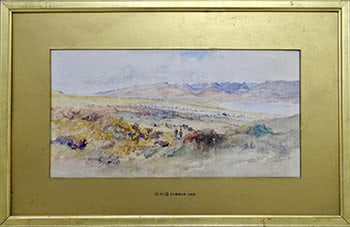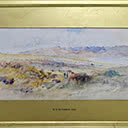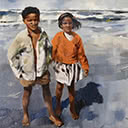GHQ Imbros
22 x 42 cm
est. $8,000 - 12,000
Provenance: Private Collection, London
Painted whilst stationed on the island of Imbros during the 1915 Gallipoli campaign. The North Aegean island of Imbros lies close to the Gallipoli peninsula. Moore-Jones was stationed here after his talent as a landscape artist was recognised by his military masters.
He was an Auckland born artist who had studied at London's Slade School of Fine Art. When war broke out, he volunteered to serve as a sapper (a solider who dug trenches and carried out general defensive duties). It was on Gallipoli that his value as a artist was recognised, from that time onwards he worked to make accurate and highly useful topographical studies revealing Turkish positions. Many of his observations were aerial, made from balloons or aircraft.
Imbros was the headquarters of General Sir Ian Standish Monteith Hamilton, a senior officer in the British Army who commanded the Mediterranean Expeditionary Force during the Gallipoli campaign. The island contained a field hospital, airfield, administration offices and supply depots.
As Moore-Jones was not a commissioned war artist he was free to sell his paintings in Britain, and later in New Zealand. This painting comes from a British collection and may well have been acquired from his 1916 London Exhibition. Two versions of Moore-Jones most famous painting, Simpson (or the Man) and the Donkey, have recently been sold at auction by International Art Centre, one fetching a record $420,000.
Jenny Haworth Author Behind the Twisted Wire: New Zealand Artists in World War I





